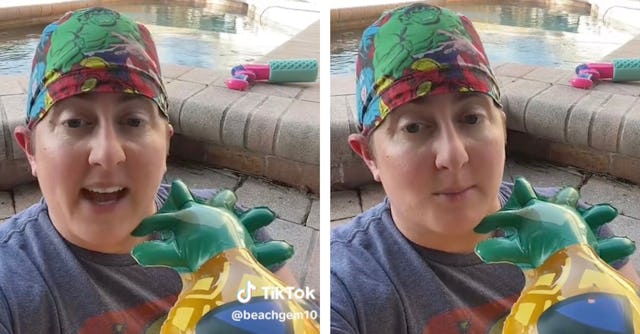A Doctor Clears Up Misconceptions About Dry Drowning & Parents Should Feel Relief
Here’s what you need to know this summer.

Summer is either right around the corner or officially here for many and that means so many fun, outside adventures — including days by the pool, lake, or ocean. While there is nothing better than a day filled with swimming in the sun, parents need to be on high alert.
Drowning deaths — which are the leading cause of death among kids aged 1-4 — can happen in a matter of seconds or minutes. This is why water safety should be a top priority for parents at all times.
There has been a lot of chatter about the concept of “dry drowning” in children. Some horror stories have circulated on the internet, striking fear into parents that “dry drowning” could happen to their child, and you’d never know.
But according to Stephen Robert, M.D., associate director of the pediatric intensive care unit at Cedars-Sinai, the term “dry drowning” is greatly misunderstood.
“The term ‘dry drowning’ refers to an acute lung injury caused by water aspiration that would develop over minutes to hours after exposure and could progress to respiratory failure,” said Robert.
A Florida pediatric ER doctor known as @Beachgem10 on TikTok — is also ready to debunk some myths about dry drowning and get straight to the facts so that parents can feel at ease all summer long while their kids run through the sprinkler in their backyard.
“Dry drowning is not real. It’s a myth that has been propagated by the media since 2017,” they begin. “The story was of a 4-year-old boy in Texas who died a week after playing in water that was about knee-high. It has been subsequently documented that he actually died of an unrelated heart condition.”
They go on to clarify that if someone has a significant submersion injury, they will aspirate water.
“The water will go into their lungs, and when they come back up, they will have coughing, gasping, shortness of breath, and the symptoms will be immediate. There are rare situations when the initial symptoms are pretty mild but then they get worse between six to eight hours later. And these situations are not just a child putting their face in the water and coming back up. These are significant events where there is a fairly large amount of water that is inhaled,” they continued.
After a significant submersions injury occurs, the phrase this doctor uses instead of “dry drowning” is “significant submersion injury.” If a parent is concerned about a “significant submersion injury,” there are certain symptoms to keep an eye out for including fast breathing, retractions, shortness of breath, blue color around the lips, vomiting, and change in mental status.
Several worried parents flooded Martin’s comment section thanking them for easing their fears when it comes to dry drowning.
“I can’t tell you how much dry drowning has consumed my thoughts after anytime my kids were in the water,” one user said.
Another echoed, “omg I was a new mom in 2017 when this rumor of ‘dry drowning’ came out and it made bath time terrifying!”
One mom asked for a bit of clarification and asked, “So is it sort of real then? Because up to 8 hours seems like a lot of time. 😳”
Martin replied, “That’s aspiration, or ‘non fatal drowning’ and there’s nothing dry about it. Still takes a lot of water.”
Scary Mommy spoke to Dr. Elizabeth Cilenti, a physician at Northern Virginia Family Practice Associates, who backed up Martin’s information.
“I would say that ‘dry drowning’ is a misconception, more than a myth, but we do get questions about it especially leading into summer,” she says.
“The idea that a child could die from a small amount of water without any sign of distress in the moment is terrifying — and makes for very powerful clickbait. Another misconception is that if someone drowns, by definition, they die — that’s not necessarily true. There is both fatal and non-fatal drowning.”
Cilenti sees “normal” drowning as a much bigger concern for parents. Thankfully, there are practical tips parents can follow to ensure everyone stays safe, including avoiding distractions while kids are in the pool.
First, Cilenti recommends that parents know the signs of a person actually drowning.
“A child who is drowning will often make no noise or splashing, so close attention is required,” she says. “Swimming lessons and water safety skills can reduce the risk of drowning — however — even children who have had swim lessons still need adult supervision.”
For those with pools in their yards, making sure pool enclosures and fences with self-closing and latching gates are secure can truly be the difference between life and death.
“Ideally this should be a four-sided fences that separate the pool from the house. If a child is going to another home with a pool or other body of water, be sure to ask whoever will be supervising about their ‘rules’ for pool safety and ensure they can provide adequate supervision,” Cilenti continued.
Lastly, if you and your kids are going to be spending a lot of time near water, consider getting certified in CPR.
“If a child drowns, early bystander CPR improves both survival and neurologic prognosis,” Cilenti advises.
The bottom line? Spend your time and effort preventing drowning, and stop worrying about “dry drowning.”